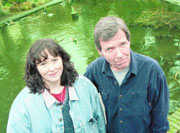LOTS OF PEOPLE in this region are ready and willing to challenge highway engineers when they suggest widening roads. But who’s to argue when the experts tell us the state Route 520 floating bridge over Lake Washington is about to sink? This is an urgent piece of business we can’t shirk. So will increasing our gas taxes by voting for Referendum 51 (R-51) this November solve 520’s problems?
Consider a few things: Only a smidgen ($170 million) of the $7.7 billion in R-51’s new transportation dollars would be directed at the 520 corridor; what’s even more disappointing is that by committing only a few lousy million dollars of the package to trip reduction programs, state leaders have already doomed a new bridge to failure.
It’s hard to imagine that any bridge the state Department of Transportation designs for 520 will unite the business concerns that want it big and wide with the politically potent mix of neighborhoods on both sides of the water that want it small and quiet. But that’s only one of many feats a new bridge can’t accomplish: It also cannot conceivably handle the traffic that’s predicted to flow daily through the translake corridor within the next two decades—no matter whether the bridge is six, eight, or 20 lanes wide. The engineers concede that they’ve met their Waterloo on Lake Washington. Nor can a new bridge promote the best strategy for encouraging mass transit ridership and carpooling—High Occupancy Vehicle lanes—without ripping out chunks of contiguous neighborhoods in Montlake and on the Eastside. Finally, a new bridge can’t do a thing to help the dozens of intersections downstream from 520 on either end that it will pump more cars into.
All things considered, the state Legislature’s offer to help us build a bridge is a very paltry gift, even if it is exactly what we asked for. Does anyone remember what happened when the I-90 bridge opened in 1989? Forty thousand new cars suddenly showed up to use it, and 520 ran as full as ever. We know that the only strategy that will ever ease congestion on Lake Washington’s bridges is reducing the number of cars that cross them. But that approach requires ongoing funding commitments—for developer incentives, bus drivers, etc.—not a one-shot capital expenditure. The evidence is already in: Trip reduction programs increase road capacity considerably for just pennies on the dollar compared to highway building. The state Interagency Task Force for Commute Trip Reduction estimated in 2001 that if such programs were fully funded, they could create as much new roadway capacity in the Puget Sound area as the I-90 bridge has. Yet for some reason, the people in the tiny offices at the Transportation Department assigned such clunky names as Transportation Demand Management Resource Center wonder every year whether they’ll have money to operate.
Meanwhile, we in the Puget Sound region are left disputing the merits of three options for a new 520 bridge—to put back only the four lanes that currently exist, add an HOV/bus-rapid transit lane in each direction, or expand to eight lanes—that we’ll never agree on and won’t solve much anyway. Neighborhood activists, public officials, and environmentalists have poured hours of creative energy into studying the translake traffic challenge, but in the end, there’s nothing left to do but choose between sizes of bottled formula. And unfortunately, that decision won’t even be made before we’re asked to vote on R-51 in November.
REJECTING THE STATE transportation package would send a strong message to legislators that we’ve got a commuting problem on Lake Washington that is too big and complex for their traditional pat response—to build a bigger highway. A bridge has symbolic power. The design of 520 will influence the transportation choices that we have to live with for another generation. So let’s take a pass on R-51, build as small a bridge as possible, and hope our governing officials follow suit by investing seriously in traffic management programs.
This response will, of course, elicit howls of outrage from commuters who suffer through the traffic on 520. And some would reasonably ask whether we’d better take what we can get from the state since we’re forced to build a bridge of some sort. I used to drive 520 daily to get to work: The delay on the bridge wasn’t nearly as frustrating or as time-consuming as the one I encountered entering I-5 in the morning. The experience is the same for westbound commuters taking 405 to get to 520: The problems at either end of this road are worse than in the middle. Returning to Seattle from Bellevue in the afternoon is tough, but a worse nightmare? Driving into downtown Bellevue, near the I-405 interchange, at lunchtime. And I’ll say this for 520—it took the same amount of time to cross it every morning. It was reliable, absent any accidents. I figure the delay 520 cost me daily was roughly equal to the time thousands of people lose willingly every day at drive-up windows.
Access across Lake Washington is as valuable as the limited capacity on phone lines that people acceptingly pay for. Tolls should pay the way for any new bridge across it. A toll system rewards public transit users, charges a premium to those whose time is too valuable to waste, and sends a message to us all that living and working on different sides of the water has financial consequences. Above all, if we only build what we’re willing to pay for directly out of our pockets, we might be surprised how beautiful a small bridge will look.









